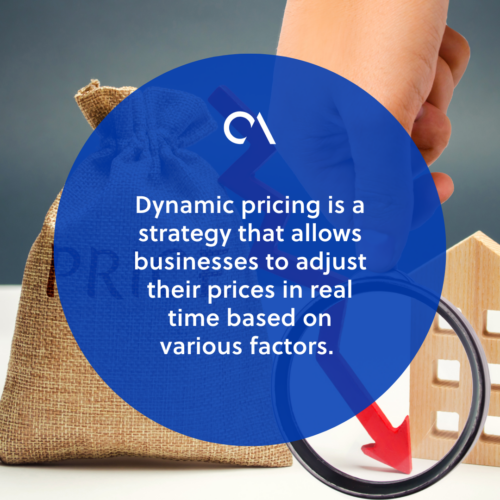Drive sales with a dynamic pricing strategy

If you’ve ever looked away from the screen while browsing your favorite online shopping website only to see the price has surged, then you’ve experienced dynamic pricing.
As technology advances and customer expectations evolve, businesses increasingly adopt dynamic pricing strategies to optimize revenue and gain a competitive edge.
What is dynamic pricing?
Dynamic pricing is a strategy that allows businesses to adjust their prices in real time based on various factors. It allows companies to offer competitive prices without sacrificing profit margins.
The idea is that you can drive more sales by adapting prices during appropriate occasions.
Dynamic pricing is also called:
- Real-time pricing
- Dynamic product pricing
- Auction pricing
- Variable price optimization
Dynamic pricing can be implemented in many ways. The most common approach is to set prices based on data collected from previous sales and inventory levels. The goal is to find the price point at which most units can be sold with the least risk.
Dynamic pricing is used across all industries, most effectively in e-commerce, retail, and hospitality.

Types of dynamic pricing models
There are several dynamic pricing models that companies can implement:
Rule-based pricing
Rule-based pricing is the most common type of dynamic pricing. It involves setting prices based on predefined rules. These rules take into account several factors, such as the time of day, seasonality, and external events.
Rule-based pricing is based more on the company’s history and experience than real-time data or algorithms.
Time-based pricing
Time-based pricing involves setting different prices for different periods during the day or week.
The purpose of this dynamic pricing model is to encourage customers to purchase goods during off-peak hours. It can be offered as an alternative to having them pay full price during regular times.
For online stores, this dynamic pricing also helps regulate network demand and prevent congestion. There are fewer users during off-peak times, so it makes sense to charge customers less for accessing the network.
This also encourages them to avoid using the network at busy times.
Demand-based pricing
This dynamic pricing model is founded on the principle that prices fluctuate based on demand. The price goes up if a product or service is in high demand. The opposite happens if there’s low demand – the price goes down.
This also works if you have a limited supply of goods and a high demand for them. You can charge more money to cover costs.
You may want to use this method if your industry has plenty of competition.
Personalized pricing
Personalized pricing uses customer data to determine which customers should pay more or less for their goods and services. For this model, you make use of customer profiles, which are created based on their past purchases or online browsing activities.
This type of dynamic pricing allows companies to offer special deals, discounts, and promotions for certain people based on their buying behavior.
Personalized pricing can also be determined based on the characteristics of the buyer. You can consider age, location, and gender. The goal is to maximize profits by charging different prices to different groups of buyers.
Predictive analytics pricing
Predictive analytics are used to predict sales volume, demand for specific products, and other trends by analyzing historical data. This form of dynamic pricing relies on statistical modeling techniques.
The goal is to make accurate predictions about future events so that business leaders can make better decisions about allocating resources and planning for future growth opportunities.
Companies are increasingly using artificial intelligence (AI) technology to adjust prices automatically.
Predictive analytics pricing is most commonly seen in retail. There, it allows companies to optimize their inventory levels and ensure they don’t run out of stock at critical times during the year.
Real-time pricing
Real-time pricing is a dynamic pricing strategy in which the price of a product or service is determined at the point of sale. The price may be changed without notice.
Real-time pricing lets you constantly keep track of competitors’ actions and changes in market conditions. In this case, you can immediately react to any changes in the market situation and adjust your prices as necessary.
This dynamic pricing model also helps vendors avoid situations where they have too much inventory on hand. They can react immediately if sales drop off unexpectedly.
Bundled pricing
Finally, bundled pricing allows customers to purchase multiple products or services as a single package. This is usually applied with a discount.
Bundled pricing is a popular option for online retailers wanting to attract customers to buy more than one product.
Bundling can be effective because it incentivizes people to buy more than one item. However, it limits the company’s flexibility to change prices and product lines over time.
How to implement a dynamic pricing strategy
Here are some techniques to consider when implementing a dynamic pricing strategy:
Define pricing objectives
Defining your company’s objectives is the first step in implementing a dynamic pricing strategy.
What are your goals for the pricing strategy? Do you want to increase profits, attract new customers, or improve customer loyalty?
Generally, there are three main categories for why a company will want to apply dynamic pricing:
- Maximize revenue – You want to capture as much of the market as possible by offering discounts to customers who will likely buy regardless of the price.
- Increase demand – You want to increase demand for an item in limited supply. Dynamic pricing works best when just enough units are available for sale at each price point.
- Maintain profit margins – You want to maintain profit margins by reducing prices when demand falls and increasing them when demand rises. Dynamic pricing is good if you have a large inventory to accommodate changes in demand at any given time.
Gather and analyze data
Whether small or multinational, a business needs to gather data about its customers, competitors, and suppliers to make informed decisions about dynamic pricing. This could include everything from customer service records to previous sales reports.
Once you have all your data together, try looking for patterns to determine what strategies will work best for your business model and customers.
A business should be able to track customer patterns to have an idea of their willingness to pay for certain products at certain times. This will help ensure your prices are not too high or too low compared to your competitors.
Identify key pricing factors
Identify all the factors that need to be considered when setting prices.
These include:
- Costs – What does it cost to produce or provide your product? Are there any fixed prices that affect the cost of each item?
- Customer segmentation – Who are your customers, and how do they differ? This helps you identify which customers are more likely to pay more for your product.
- Competitive landscape – How do other companies in your industry set prices? Are any new competitors entering the market?
- Product type – Different products have different price points, so make sure you know what your competitors are charging for similar products.
- Demand and supply – If there’s a high demand for your product but little supply, raising prices to maximize profits makes sense. Lowering prices could help move more units off the shelves if supply is high and demand is low.
- Seasonality – The pricing of certain products will differ depending on their seasonality.

Develop pricing models
Pricing models are mathematical formulas that calculate the price of a product based on changes in factors like seasonality, competitors’ prices, and cost of goods sold. These models can create pricing strategies for different customer segments, products, and channels.
These models also provide a framework for making changes based on market conditions.
Set pricing rules and parameters
Setting pricing rules and parameters includes defining when prices should change, how often they should change, and by how much. You may also want to set rules around whether or not certain products can be discounted during certain periods of time.
Some pricing rules and parameters include:
- Price floors – These are the minimum prices you’re willing to sell your product or service.
- Price ceilings – These are the maximum prices you’re willing to sell your product or service.
- Target margins – You want to make this profit on each sale.
Communicate pricing changes
When practicing dynamic pricing, any changes should be communicated to customers through relevant channels before the change is implemented. This will help reduce the risk of overcharging customers who don’t know about the new prices ahead of time.
On the other end, this also helps prevent miscommunication and confusion by giving customers the opportunity to adjust their expectations.
Test and refine
Dynamic pricing isn’t for every company or industry. It works best for those with high-margin products or services that are in demand during peak periods.
Before you start adjusting prices, test the model by changing prices manually over time, looking at the results, and refining the algorithm as necessary.
Test different price points to see which ones yield the highest revenue per visitor or customer. You can also test different discounts or incentives to see what works best for driving sales at various price points.
Understand how customers respond to different price points. You’ll need to analyze data from various sources, including historical sales and customer surveys.
This way, you can develop strategies that will allow you to maximize revenue while satisfying customers’ needs and expectations as much as possible.
Monitor and optimize
When you’re implementing a dynamic pricing strategy, you need to monitor your results and optimize accordingly.
Monitoring is important because it allows you to see what’s working and what’s not. You can use this information to adjust your pricing and target customers with the right offer at the right time.
It’s also recommended to track and analyze your competitors’ prices to stay ahead of them.
Benefits of dynamic pricing
Dynamic pricing has gained significant attention in the business world due to its numerous benefits. By leveraging this strategy, companies can unlock several advantages contributing to growth and profitability.
Let’s delve into some of the key benefits of dynamic pricing:
Maximizing revenue and profitability
Dynamic pricing allows businesses to optimize prices based on factors like real-time market conditions and demand fluctuations. They can capture the maximum value from each transaction, resulting in increased revenue and improved profitability.
A dynamic pricing strategy ensures that prices are aligned with customer preferences and their willingness to pay. This ultimately maximizes the company’s overall financial performance.
Enhanced customer satisfaction and loyalty
Personalization is at the core of dynamic pricing. Businesses can tailor prices to individual customers based on purchase history, loyalty status, or location.
This approach makes customers feel valued and understood, leading to increased satisfaction and loyalty.
Optimal inventory management and waste reduction
Dynamic pricing helps companies effectively manage their inventory by aligning pricing with demand levels. Matching prices based on supply and demand lets businesses avoid under or overstocking situations.
This ensures that products are sold at the right time, reducing waste and the need for costly clearance sales. Efficient inventory management reduces costs and enhances operational effectiveness and customer experience.

Competitive advantage and market responsiveness
Implementing dynamic pricing strategies provides businesses with a competitive edge. By continuously monitoring market conditions, competitor pricing, and customer behavior, businesses can respond swiftly to changes in the market landscape.
This agility allows them to offer competitive prices, adapt to market trends, and stay ahead of rivals. Customers appreciate brands that are responsive to what’s currently “in,” which positions you as forward-thinking and customer-centric.
Data-driven decision making
Dynamic pricing relies on data analysis and insights to inform pricing decisions. Businesses can gain valuable insights by leveraging data analytics tools and techniques.
These insights enable companies to make informed choices and identify new opportunities more accurately.
Flexibility and experimentation
Dynamic pricing grants businesses the flexibility to experiment with various pricing strategies and approaches. You can test different models to determine the most effective strategy for your products and services.
By experimenting and adapting, companies can keep optimizing their pricing approach for better outcomes.
To conclude, dynamic pricing is a powerful tool that brings several advantages. Implementing dynamic pricing requires careful consideration and monitoring.
However, the potential benefits make it an essential strategy if you’re aiming to thrive in a competitive environment.







 Independent
Independent




